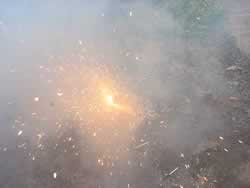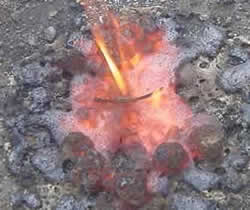Making sparklers
Making sparklers is an exciting activity that vividly demonstrates the energy released in chemical reactions.
Carefully
weigh the following
10.0
g iron powder
0.5
g magnesium powder
2.0
g aluminium powder
6.0
g potassium chlorate
25
g barium nitrate
Place
6.0 grams of soluble starch in a 100 ml beaker. Add 15 ml of warm water
and stir into a thick paste. Add the mixture of the above chemicals
to the starch. Role the mixture into a long cylindrical shape or into
small spheres. Allow to dry overnight on
bench top.
When
dry use a lighter to ignite
it. Keep students at least 5 metres away. Only ignite the mixture outdoors.
The
chemicals used are reactive and small hot pieces of metal will shoot
into the air. Proper eye protection should be worn.
The
nitrates and chlorates decompose
on heating to produce oxygen gas. This oxygen gas ignites the metals
and shoots them out.
Write
the equations below in the form of a proper balanced chemical equations.
Aluminium
and Oxygen gas àAluminium oxide
Al
+ O2 à Al2O3
(Balance this equation now)
Magnesium
and Oxygen gas à Magnesium oxide (MgO)
Iron
and oxygen gas à iron oxide (Fe2O3)
Barium
nitrate à Barium Oxide (BaO) + Oxygen
gas (O2)

A great deal of heat is produced and the reaction quickly accelerates. Students should stand back at least 5 metres from the burning sparklers. Click to see a 120kb video.
Click to see how quickly the same sparkler mixture ignites when in powder form. Why does powder react quicket than the small spheres?

